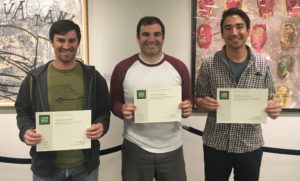This post was written by Samuel Carey ’18
This year three Sustainable Innovation MBA students, ambitiously seeking to foster a greener economy, took on an additional workload outside their already busy schedules to prepare, practice and pass the test to become LEED Green Associates. Samuel Carey, Christopher Norcross, Robert Hacker (in photo, below, left to right) attended a LEED training workshop late in the fall, and spent the spring preparing. The final exam was not easy, but they all did fine. They are even contemplating going after the next level of certification becoming LEED Accredited Professionals, which would allow them to work as auditors.
 Today, the importance of LEED is underestimated, and the students believe that it will soon become the norm, becoming part of all building codes. The built environment accounts for more than a third of our total energy usage, as well as an immense amount of fresh water. And buildings take up a lot of space, disrupting natural drainage systems and increasing the urban heat island affect. Leadership in Energy and Environmental Design (LEED) is a certification system made to create greener buildings and more livable urban environments. It is estimated that people will spend up to 90% of their time indoors, so it makes sense to prioritize both healthier and more environmentally friendly buildings.
Today, the importance of LEED is underestimated, and the students believe that it will soon become the norm, becoming part of all building codes. The built environment accounts for more than a third of our total energy usage, as well as an immense amount of fresh water. And buildings take up a lot of space, disrupting natural drainage systems and increasing the urban heat island affect. Leadership in Energy and Environmental Design (LEED) is a certification system made to create greener buildings and more livable urban environments. It is estimated that people will spend up to 90% of their time indoors, so it makes sense to prioritize both healthier and more environmentally friendly buildings.
Rob: “I like it because it’s making the human built landscape better work with and co-exist with the natural environment.”
The students were impressed by the organization and stages of development of a LEED project. They saw significant overlap amongst topics and core concepts from their SI-MBA course work. LEED projects start with stakeholder engagement and cross-functional team planning in a process called a Charrette. There, they must decide what characteristics the design will prioritize, and in which LEED categories it will receive points (i.e. Energy, Water, Sustainable Sites, Transportation, Materials and Resources, etc.). There are certain prerequisites that all LEED certified buildings must adhere to, but the remaining points are awarded as credits from a list of many. This enables the design team some flexibility and creativity. LEED awards more points for certain aspects based on overall priorities. Reducing greenhouse gas emissions is the highest priority goal, so more credits are awarded for implementing energy efficiency, benign refrigerants and renewable energy.
Chris: “It’s awesome that they’ve been able to standardize sustainability in building infrastructure.”
Overall the LEED GA certification was an incredibly rich learning experience. The students think that some LEED training should probably be integrated into the SI-MBA program as the concepts and strategies are indeed incredibly impactful to continue transforming today’s businesses and creating tomorrow’s ventures!
Sam: “The fact that LEED certified buildings deliver on the triple bottom line really proves the case for sustainable business.”
